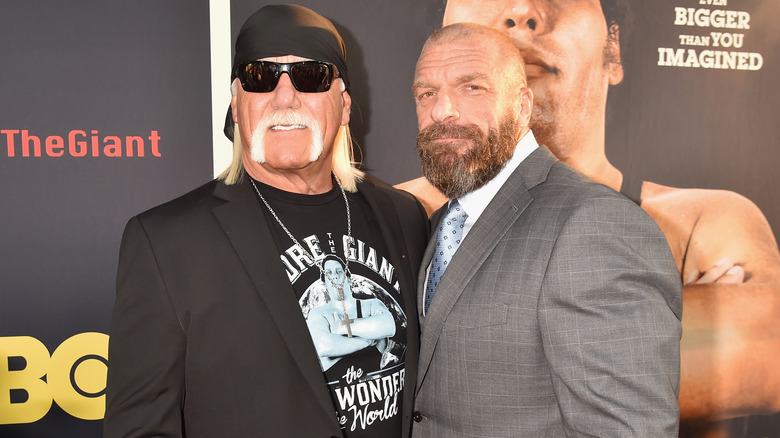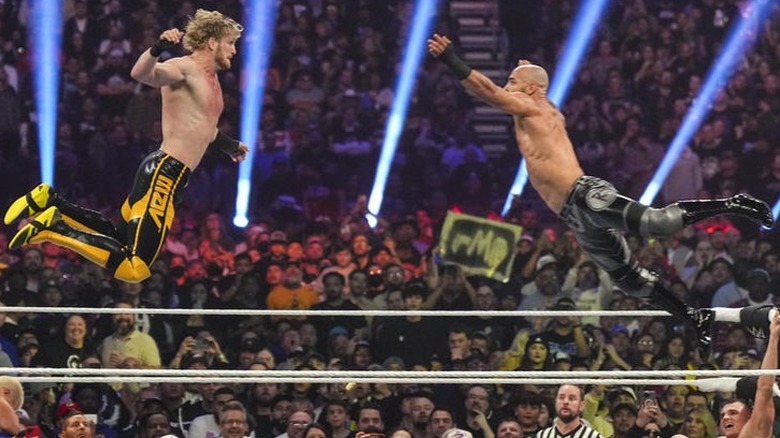Hulk Hogan On How Professional Wrestling Has Changed As An Industry
As a man who dominated the two greatest "boom" periods in wrestling history, Hulk Hogan is as qualified as anyone to break down the changes the industry has undergone over the years. Talking with "Full Send Podcast," Hogan did exactly that, but prefaced his comments by emphasizing that he had no intention of "knocking the product" put out by promotions such as WWE and AEW.
"I think the biggest difference would be two things: the internet stuff, you know, because I sold a ton of merchandise with no internet, Amazon, or any of that stuff. It was always venue-related [sales] or mail-order stuff. So, I sold a ton of merch over the years, and am still selling like crazy. So, I'd say the internet is the biggest difference." As for the second biggest change, Hogan says the industry has moved away from the model of featuring "one big attraction," and instead focuses on an ensemble of men's and women's wrestlers.
"I think the star now is the production of the show," Hogan added. "Because I see the guys wrestle, and if one gets hurt, there's another from the Performance Center that just slides right in and takes his place. They're all the same size, have pretty much the same color of hair, and have their clothes made by the same seamstress. They learn to wrestle from the same group of trainers. When I got into the business, we all learned by wrestling every night by getting our asses beat up. We didn't do forward rolls with helmets on, with doctors, masseuses, and trainers [for assistance]. If you hurt your thumb, you go to an X-Ray machine. 'Take four weeks off, you broke your nail.' It's different now, you know?"
Hogan Marvels At Athleticism Of Modern Wrestlers
Hogan also touched upon how he and his fellow wrestlers would travel constantly, wrestle 300 nights a year, and party like there's no tomorrow. When asked where the "party culture" associated with the bygone era originated from, "The Immortal One" clarified that the culture existed across the wrestling business and wasn't restricted to WWE.
"When I walked into a dressing room, there were like six guys sitting there," Hogan recalled. "They're all 300-pounders and I'm a medium-sized guy. So, when I got in, it's like there's a guy there with two big cauliflower ears, a broken nose, knocked out teeth, and he's got four kids at home. The next guy was an NCCA Champion with a steel plate on his forearm, his name's Harley Race. Well, good luck with him. The other two guys are like serial killers, and if you want to be a wrestler, you have to take their job and food out of their family's mouth. That's the difference." Hogan elaborated that most of the wrestlers he worked with were "monster-sized" whereas some of today's wrestlers resemble "guys who could be bagging groceries."
Hogan offered props to the level of athleticism in today's wrestling, stressing that the wrestlers do "so much impressive stuff in one match" that he wouldn't have done in a whole year. When Hogan returned to WWE to host WrestleMania 30, he noticed a lot of these changes, especially the writing teams assisting wrestlers with their character and promos. Hogan says that "nobody told me how to be Hulk Hogan" and he came up with the creative aspects of his character himself. "I'm getting ready to walk through the curtains, and a writer comes up to me and hands me these papers. I say to Vince [McMahon], 'Really? Are you kidding? He says, 'Nah, do whatever you want.' I threw the papers away!"

